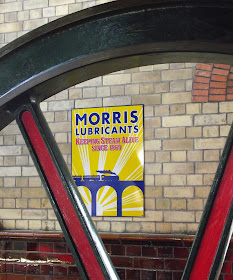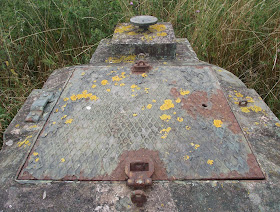Archaeology : Architecture : Art : Cold War : Curiosities : Design : Eccentricities : Ekco : Engineering : Industrial Heritage : Military : Petroliana : Photography : Shed Wonders : Transporter Bridges : Vintage Technology
29 September 2013
Satellite Television
At its Foot Cray factory, Kolster-Brandes made televisions alongside radios. Trading on its long association with Cunard, KB gave a number of its TV sets the name Royal Star. The 17-inch PVP20 model is a classic of 1950s colouration and Sputnik-inspired design - lilac-grey wrap-around wood fibre cabinet, salmon mask, white urea formaldehyde controls, gold trim, and bright red feet. When first sold in 1958 the set cost £61 19s 0d including purchase tax.
19 September 2013
Vélo Moto Auto

The National Weapons Factory at Châtellerault, in the department of the Vienne, Poitou-Charentes, was established in 1819 to manufacture swords. It later made rifles, such as the Lebel type. The factory closed in 1968.
Housed in one of the former factory's buildings is Châtellerault Motor Museum, built around the personal collection of Bernard de Lassée. The collection includes a representative selection of early vélos, including hobby horses, penny-farthings, and safety bikes.
It moves through the history of the moto and the auto, and includes gorgeous examples of Panhards, Delahayes, Darracks, and, of course, Peugeots. There's a smattering of American cars, but it's the French weird and wonderful that catches the eye. Hautement recommandé.
14 September 2013
Steaming Sewerage
Coleham Pumping Station was built inside-out. W.R. Renshaw, of Stoke, built on site two steam-driven Woolf beam engines in 1897/8, to pump Shrewsbury's sewerage. The building was then erected around the engines in 1900, and opened a year later.
The rotative beam engines are compound, with side-by-side high pressure (13 inch bore) and low pressure (20 inch bore) cylinders, together producing about 25 horsepower. The piston rods connect to the beam by means of James Watt's parallelogram coupling, enabling the up-and-down movement to be connected to a beam that moves in a slight arc.
With the pistons moving in a straight line, they can be driven from both above and below. Watt's double-acting cylinders saved greatly on coal, and he took a share of the saving on an ongoing basis. Fitted to the side of the cylinders is Watt's device for measuring the efficiency of his engines, his means for checking the amount due for energy not used.
The engines drive flywheels of about 16 feet diameter and 10 tons weight, the inertia of which then drive the pumps, able to move about 1,200,000 gallons per day, exceedingly smoothly. A two-pence piece will balance on its side upon the moving beam without falling over.
Two Cornish boilers by W&J Galloway, of Manchester, 21 feet long and five-and-a-half feet wide, provide the steam. The fire sits at the front of the furnace tube, through which pass the fire's hot gases. The tube runs to the back of the boiler, then under it, and finally along its sides, such that the water is heated from both within and without.
The coil-fired boilers and beam engines drove the pumps until 1970, when submersible electric pumps were installed in the sewerage pipes. It wasn't until 2003 that the pumping station was disconnected from the town's sewerage system. The Shrewsbury Steam Trust has restored the boilers, engines and pumps to the highest of standards.
The rotative beam engines are compound, with side-by-side high pressure (13 inch bore) and low pressure (20 inch bore) cylinders, together producing about 25 horsepower. The piston rods connect to the beam by means of James Watt's parallelogram coupling, enabling the up-and-down movement to be connected to a beam that moves in a slight arc.
With the pistons moving in a straight line, they can be driven from both above and below. Watt's double-acting cylinders saved greatly on coal, and he took a share of the saving on an ongoing basis. Fitted to the side of the cylinders is Watt's device for measuring the efficiency of his engines, his means for checking the amount due for energy not used.
The engines drive flywheels of about 16 feet diameter and 10 tons weight, the inertia of which then drive the pumps, able to move about 1,200,000 gallons per day, exceedingly smoothly. A two-pence piece will balance on its side upon the moving beam without falling over.
Two Cornish boilers by W&J Galloway, of Manchester, 21 feet long and five-and-a-half feet wide, provide the steam. The fire sits at the front of the furnace tube, through which pass the fire's hot gases. The tube runs to the back of the boiler, then under it, and finally along its sides, such that the water is heated from both within and without.
The coil-fired boilers and beam engines drove the pumps until 1970, when submersible electric pumps were installed in the sewerage pipes. It wasn't until 2003 that the pumping station was disconnected from the town's sewerage system. The Shrewsbury Steam Trust has restored the boilers, engines and pumps to the highest of standards.
09 September 2013
ROC Post - Inside View
As previously documented, over 1,500 underground posts were built across the UK during the 1950s, from which the Royal Observer Corps would, it was naïvely supposed, report on the number, location and strength of nuclear explosions.
The post at Nesscliffe, Shropshire, has no padlocks on the hasps of the access hatch, and the Torlift lock is easily opened with the aid of the right tools. Although the paint is peeling, the shaft is in good condition.
The sump pump at the foot of the shaft is still in place and serviceable (above). To the right of this, the toilet cubicle retains its Eltex chemical toilet.
The chamber of the post has been largely stripped, but there are small remains of the Bomb Power Indicator (above). As was common, the post was built at the same site as the aircraft spotting and identification installation associated with the ROC's earlier function.
At Nesscliffe there remains a hut associated with the earlier spotter facility. Inside there is an old stove at one end, and the ubiquitous chemical toilet at the other.














